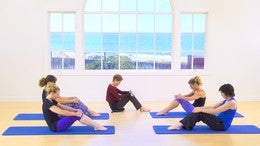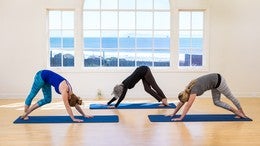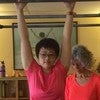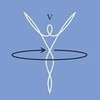Tutorial #2591
Knee Stretches Illuminated
Description
About This Video
Transcript
Read Full Transcript
Well. Hi and welcome back. It's so great to be with you again and I am thrilled to be here with Amy. So yeah, it's really special. We are going to explore together nice stretches and we're actually calling it knee stretches illuminated because as much as I'd have knee stretches is one of this whole series is one of my favorites in Pele's. Uh, but I think it's a huge opportunity when we look at the different exercises, how we begin to discover what's actually happening. As I do the knee stretches. This is my, my wonderful little flowing skeleton that I got through one of my mentors many years ago and look at this amazing little guy calling flow simply because, um, has the ability to move fully through joints.
And that's what we're really looking at. How do we move fully? How do our joints, when we talk about 10 segregated [inaudible], what do we really mean by that? What is the true tensegrity of a joint? How do you remember the bones remodel? But the bone actually as it's as being pulled on through the soft tissue and Fascia, all the way from hand, head to foot is remodeled in the way that it's used. So that's why it's so important to know what it is you're doing when you're doing it and to keep refining your understanding of it so you don't just do it one way and then it may or may not be best for you.
How do you keep refining your understanding? So thank you so much flow. Let's look for a second at um, some images that I teach through. And you'll notice on the first one it's called, it's the three core connections understanding of down the back. And what this image is, is, um, is depicting, is our relationship to gravity.
What is that sense of notice on the image that the yellow shoulderblades have a little circle at the bottom. That's the inferior angle of the shoulder blade and how that has a waterfall action on the spine as we exhale so that the little circle is related to the way in which the spine relates to gravity through the sit bone. Tailbones there a little circles there through to the heel of the foot to the tripod of the foot. There's a relationship to gravity that's natural for us. And that's why I have three white circles that show the lower core.
There aren't three cores in the body, but that's the way that we wrap our heads around how our body relates to itself in relationship to the gravitational field, how we relate to gravity in space. That's what we're talking about. So the lower core foot to pelvis is deeply related to the central core, which is pelvic floor to diaphragm, which is deeply related to diaphragm, to pallet cranium, arms connected in upper core. How do our arms relate to our legs? You see, how is Amy and I are exploring today that is hugely related to knee stretches and every exercise that we do. So the down the back in our, uh, three core connections perspective is related to up the front and wakes up the, uh, natural uplift, what we call the domes of uplift, the dome of the arch of the foot, the arch on dome of the pelvic floor, the Dome of the respiratory diaphragm, the dome of the Cerasis inlet, how your armpits open and how that widens your chest and widens your back, the dome of your palate and the dome of your cranium. So this is a natural uplift that we don't need to do anything with and that's what's hard for us in delays. So that's called up the front and the down creates lift.
We're going to say more about this in another class that you'll be able to really see more deeply when we talk about our Cobra spine and the primary and secondary curves of the spine and how the whole inquiry of gravity and ground reaction force. Actually I got a deeper understanding of that and studying with Judith Aston, who I'm deeply grateful to and who is now plot. He's anytime, so don't miss her, she's great. But once again, don't feel like you have to, I can only do it this way. This is the way to do it, because that's not what she's teaching. She's teaching. Just get in touch with gravity and then play, be in your body. That's what we're doing. Okay, so Amy, let's begin with, um, first of all, let's look at the grit, the grounding of knee stretches. So the first thing we're going to do, you're not expecting, we're actually going to look at how do you sit on the ball of your foot? Because the relationship of the reach back of the legs is totally related to how much can you sit down on your heels.
This is a practice toe said. How do you sit down on your heels? How does that relate to the releasing back of your Achilles tendon to allow the lift to happen through the arch of your foot? Because you can't get the down. Excuse me. You can't get the up without getting the down. You first of all have to get the reach through your Achilles to get lift.
That's what's happening. Yes. So it stinging, the thing you want to watch is if it's hurting, you really don't want to stretch ligaments in your toes. What you want to do is you want to put, let's put this, get, get a towel or a pad or something and you're rolling it up and I'm going to put it right under the ball of the F of a Amy's foot. So now she's on the ball of her foot. So it's not, the pressure's not on her toes, it's on the ball of her foot. That's where you want the pressure. You want to bring gravity up. Yeah. The other thing is to put a little more behind her heel.
So you're encouraging the reach back.
I am feeling a lot of engagement right here. You know, it's not in my joints right now and my toe joints, but like it was. So there's what you're noticing is that there is a, an engagement, but does it feel like there's more of a reach into your feet? I can feel that. Yeah. I know I can. Yeah. And what's interesting about that that I'm going to ask Andy is does that release allow you to feel more support and lift through your pelvic floor, lift along your spine? That's what's interesting. You say it's not about doing something to yourself, it's about what happens when you create support that creates a related
So that's one you can do that. I'm going to take that out so that Amy can let her feet rest for a little bit. Yeah, right. It is good. Yeah. All right. The next thing we're going to show is that may be good and you may want to do that or this or both, so you're just going to see what works for you. How do you keep creating change so you're really getting deeper.
So we'll do the one where you're putting these under your knees. This is another way of supporting. I brought gravity up so our needs are higher, which allows more resting back. That's another way to get deeper into the ball of thought because you brought the knees up, allows her body to rest down, allows her heels to reach back. Then creates lift up with the down. Yes, the down creates lift and it keeps saying it that way because that's, that's the message we want to get and every exercise. Beautiful.
Okay, good. Yeah. Yeah. It's amazing. It's amazing. But see this is, this is going to put you into a deeper awareness and understanding of not just knee stretches, the whole long stretch theories. You have trouble with Arabesque. How do you get deep into the reach back? You have trouble with swan on the box because the heels are not reaching back so you don't get lift, so you're always stuck. Doesn't happen. You see, you start releasing over and over and over again or getting into it. Great. So now we're going to begin.
Now we're going to go into the first part of knee stretches. When we want to find the hover, you want to feel what is lifting up? How do you feel a relatedness? How do your arms yet rooted to your spine? You see, how was your arm as I, you're pressing to me just a little bit.
Now relax your shoulders and feel the waterfall down the back. Keep feeling the waterfall down. Yeah, I can see how that's feet foot to hand. So you want to get that feeling of how do your hands relate through your breathing spine to your feet. Very different than pull your belly in. Pull your shoulders down, which really what that does is it locks out your back and it will lock out your neck. We'll talk more about this when we go into primary and secondary curves.
So Amy, let's put a one spring. You want one spring for this because you want to find what's just enough effort for the movement. What's just enough? First of all, feel a sense of weight shift. Feel the right side sense. Wait there. Can you relax into your lower arm and allow your upper arm to relax and feel it connecting? Yeah. Yes. Yeah. See that?
So you want your shoulderblades good. And I'll go forward just a little bit more there. There we go. So the waterfall allowed her head to release in that direction. Great. And then from there, inhale, press gently out. Exhale and come back in. Yes.
And I'm just putting my hand here so she can feel the breath and newer back as she goes out. And the shoulder blade to deep belly connection. This is a new version of the pads, a more updated version of the powerhouse. How do we not just pull the belly in? How do we feel the breathing spine as we move legs and arms rooted to the spine. Moving. Yeah. Beautiful. How do your hamstrings wake up?
How does that connect to your deep spine? Front of your spine, to your inner ear, down the back, up the front. Wonderful. And stay in those gorgeous. So now we go to round, back knee stretches and let's see, I think we sound, was it that one that worked best for you in between? Yeah, we're kind of looking, you know, you want to really look for the what river, the reformer you have. You're looking for the height of the bar that allows you to release so that you get the waterfall. If you're bars too high or too low and you feel that you're jammed or that you're too, too heavy, it will be hard for you to organize yourself.
So see what allows you to feel that sense of relaxing into your hand. And how can you allow the soft release of the down give you lift and reach back through your heels as you inhale. Exhale. So now we have two springs on. This is classical flow. Inhale out. Exhale. Once again, I'm giving Amy just a sense of waterfall and lift, right? How do we're legs float from the shoulder blade to deep belly support.
Inhale and exhale. Very good. And come in and now gently undulating, releasing the tail. That was beautiful. Moving from her tail coming up, you want to feel how the flection of the spine moves into a natural extension. They're not separate from one another. They're each part of one another. They move together and so inhale to go out.
Exhale. That's right. Your tail is floating. That's it. Yes. Yeah. How does the waterfall create the lift? Yes. How do they work together? The down gives you lift how to reach to the whole foot and lift or the inner ankle to the inner ear. Oh yeah. That's it. Yes.
Because it's the way you do the basic exercises that informs how you do the advanced work and come back in. Beautiful. And then you round. So here's a great transitional movement toward knees off. We'll do one knee off. So right foot goes forward. You're on the ball of the foot. Keep letting that heel feel heavy, but feel the hover of it as just a gentle release.
But notice how she doesn't have a really high heel. That's hard to keep the heel just floating like that because the tendency is to want to grip your Achilles. There you go. So keep that feeling of the waterfall down the back and feel the lift up the front as you exhale. Inhale out. Exhale. Very good. Dive your head. Dive your tail. Yes, you want this feeling of hot air balloon. How do you breathe into your back? How does a shoulder blade to deep belly allow you? Yeah, that's it.
Legs floating from the breathing spine and stay in gorgeous other side. And you want to notice what each side feels like. Cause everybody has one side that's stronger. One side that's not as strong. So give each side. You don't want the the side that works more efficiently or it feels easier.
You don't want that side to take over the other side. So you're really, so once again, giving support. Feel the support. You're asking gravity to help your body to keep balancing and feeling that we are, we are asymmetrical. We're not going for everything. Being totally [inaudible] symmetrical. It just doesn't exist in any human being. We're not supposed to be. We're supposed to be ourselves. We're like nature. And then we go inhale,
Feel the waterfall down. Gorgeous. That's it. Yes. Last one. And stay in was beautiful. It was really good. Really good. Yeah. It's just nourishing, isn't it? See, this is nourishing movement, which is the poll purpose of what Joseph is called. Return to life. We are. So now let's go to nice off. Okay.
I'm pulling the shirt down her back so she can really feel down. Give her lift. Yes. And Stay N.
What's next? What's next? See, how can it be not hard, right? How can it actually be like a natural progression, which is the intention and how can we be present to what's happening so that what we're doing is we're, you're, you're discovering over and over and over as in the way that you're approaching the movement, what your body needs. So you'll find that as you get older, and I'm even talking to people who are younger right now because your body's always changing. And we don't usually think about that until we're 70 years old. And it's like, what's wrong with me? Why can't I do what I did with 30? You know, we'll, there's nothing wrong. Your body wants something different.
You know, I'll be 70 next year, and I'm just, I'm like so blown away by how much my body is teaching me because I've learned to listen.
Comments
You need to be a subscriber to post a comment.
Please Log In or Create an Account to start your free trial.

















